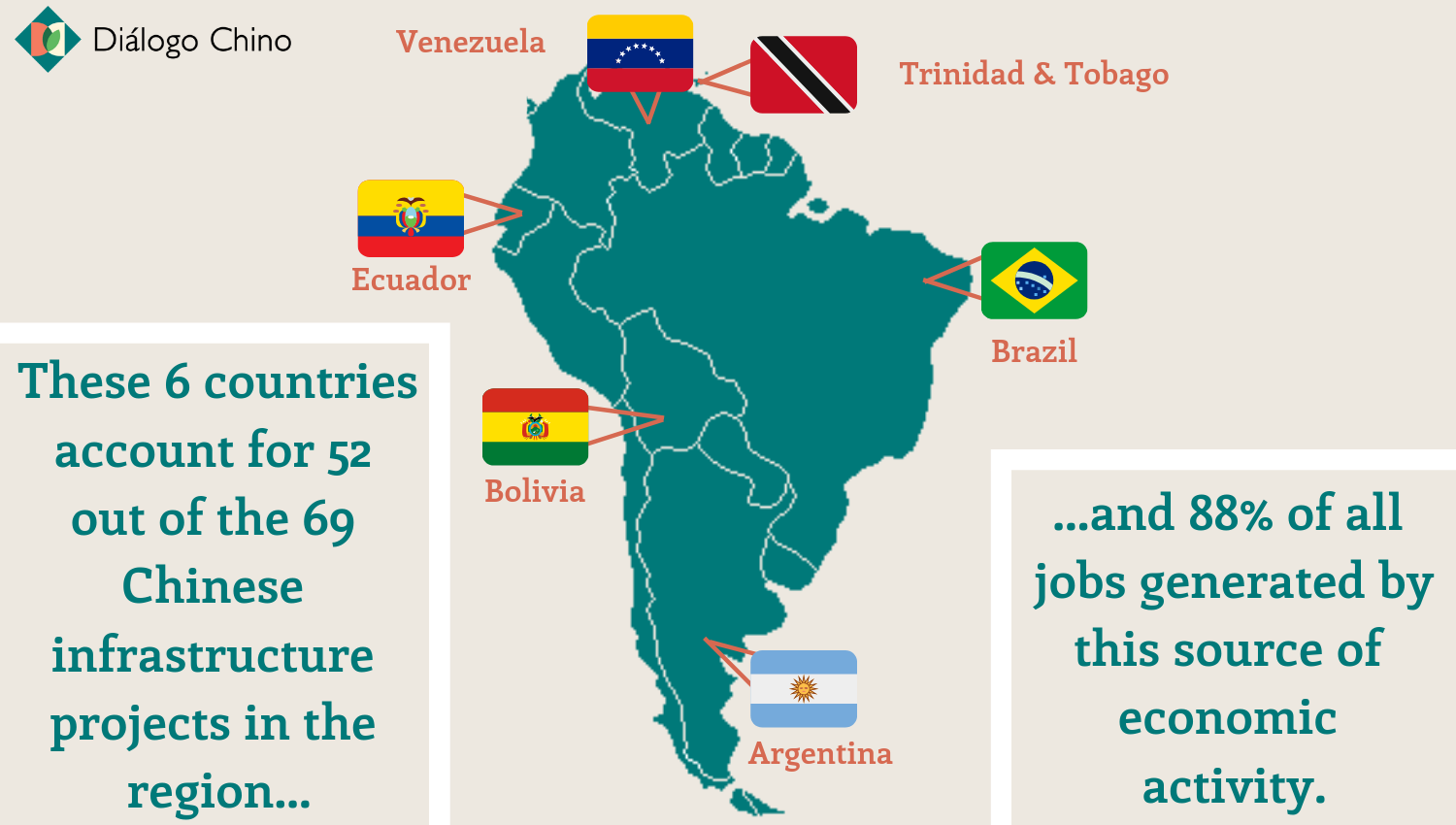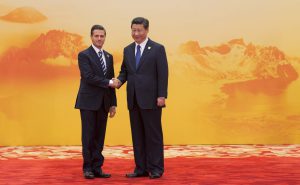A period of intense economic engagement with China generated 1.96 million jobs in Latin America but employment is largely low-skilled and unevenly distributed across the region, new research by the International Labour Organisation (ILO) shows.
Between 2000 and 2017, Brazil’s workforce swelled by 1.6 million as a result of trade with China, Chinese foreign direct investment (FDI) and infrastructure projects. Whereas Mexico lost 350,000 jobs, owing mainly to imports of Chinese products that compete with its own, according to the study, Effects of China on the Quality and Quantity of Employment in Latin America.
“Given Latin America and the Caribbean’s need to generate jobs, two million is really significant,” said Enrique Dussel Peters, co-author of the research, which also collects data from Argentina, Peru and Chile.
The new figures, which build on the first of their kind compiled in 2016, show that trade accounted for the largest share of new jobs, followed by FDI and then infrastructure projects. The previous study held China responsible for 2% of net job creation in the region between 2000 and 2011, or 1.15 million jobs. Though growing, the figure represents just 14% of jobs generated by the same sources in the US in the same period.
Crucially, the low proportion of new high-skilled jobs appears to reflect some Latin American countries’ stubbornness to diversify away from raw material exports to industries that add value. Regional leaders and Chinese counterparts have pledged to work together to achieve this, a process known as ‘upgrading’.

Winners, losers and outliers
Brazilians gained significantly from economic exchanges with China in terms of employment, with major infrastructure projects playing a big role. Publicly-owned Chinese energy company State Grid alone created 100,000 jobs, including 17,000 on its 5,000 kilometre Amazon-bisecting hydroelectric transmission line.
A handful of countries – Argentina, Bolivia, Brazil, Ecuador, Trinidad & Tobago and Venezuela – account for 52 of 69 Chinese infrastructure projects, which equate to 85% of their total value and 88% of employment generated in the region by this source of economic activity.
However, across Latin America, the main engine of employment remains the production of China-bound commodities such as oil, copper, iron ore and soy.
Throughout the region, agricultural exports contributed to the largest share of new jobs created by China since the turn of the century, some 1.7 million. Worldwide, however, technological advances and greater efficiency in these sectors have begun to displace workers in recent years.

While Brazil has attracted most interest from Chinese investors – US$48 billion, according to the China-Latin America Academic Network’s OFDI monitor – its prolonged political and economic turmoil has led many to look elsewhere for fertile investment environments.
“Crises in Brazil, Argentina and Venezuela and the current and future benefits Chinese companies have spotted in Mexico have played an important role,” said Dussel Peters, referring to the increase in Chinese FDI flows to the North American country.
While Mexico leaked jobs through trade with China, it benefitted from US$5.5 billion in new Chinese FDI in 2017. The figure is 21% of the total share received since 2000 and translated into 24% more jobs from Chinese FDI than it had in the entire 16-year period preceding it.
Unusually for a big Latin American economy, Mexico does not base its relationship with China on the trade in raw materials. While it has opened up its energy sector to foreign investment for the first time in 80 years, China channels most FDI in Mexico into manufacturing and the domestic market.
Labour conflicts
In Peru, the Las Bambas copper mine in the Apurimac region, accounted for 42% of all China-led employment in the country last year. There, disputes over environmental impacts have paralysed operations on occasions. Two other big employers in the sector, Shougang, whose troubled iron ore venture accounted for 25%, and China Minmetals (19%), owner of the Toromocho copper mine, have also witnessed violent conflicts with workers.
Incidents do not arise from abstract “cultural differences”, as is often suggested, but by Chinese companies’ refusal to abide by host country labour laws
At Shougang, worker protests against the company’s introduction of more flexible working hours turned violent in 2015 amid accusations the company hired agent provocateurs to justify a crackdown on disgruntled employees.
According to the ILO report, such incidents do not arise from abstract “cultural differences”, as is often suggested, but by Chinese companies’ refusal to abide by host country labour laws.
Labour disputes have also flared up at infrastructure projects staffed by low-skilled Latin American workers and Chinese managers, engineers and technicians.
This divide, and the lack of training and knowledge transfer from China to Latin America, is a longstanding problem identified by experts monitoring the relationship, who say the region enjoys fewer long-term benefits than it should.
A soon-to-be published paper by researchers at the University of Colorado examines the impacts of China’s 2001 entry into the World Trade Organisation on the Peruvian labour market, noting a sharp increase in trade but “negative and long-lasting” impacts on employment.
Industries that compete with Chinese imports suffered most. Low-skilled female workers were worst affected while employment for male counterparts scarcely changed.
“It is increasingly essential to examine the gendered labour market impacts of trade liberalisation,” according to co-authors Andrea Velasquez, Hani Mansour and Pamela Medina. They added that displaced, mostly female, workers have limited ability to move into more productive sectors of the economy but that the government can help.
“Policies aimed at increasing the mobility of women across sectors, such as training or education programmes, could potentially mitigate the negative impacts of trade,” the economists recommended in an email to Diálogo Chino.
Low-carbon transition
In Chile, the renewable energy sector has brought employment opportunities with US$6 billion of Chinese investment generating over 10,000 jobs in new wind farms, solar plants and LED street lighting.
Social groups’ preconceived idea about China as seeking only raw materials simply doesn’t stand up
Shanghai-based Envision Energy’s Chilean operation invested US$33 million in a wind farm with an installed capacity of 10MW. Chinese company JA Solar’s joint venture with Soventix Chile SPA will create large solar farm while Jinko Solar is working with Chile’s national energy agency (ENEL) on a 100MW plant. Sky Solar Holdings plans to add a further 300MW.
According to Dussel Peters, China’s role in Latin America’s transition to cleaner economies is only likely to grow, helping dispel the myth that Chinese companies in the region act as a resource-hungry monolith with little care for the environment.
“Social groups’ preconceived idea about China as seeking only raw materials simply doesn’t stand up,” he said.
A 2016 Chinese Ministry of Foreign Affairs (MFA) white paper pledged to “align high-quality capacity and advantageous equipment of China with the needs of Latin American and Caribbean countries.”
By developing secondary industries with Chinese investment and technology, some Latin American countries could “upgrade” their economies and reduce the dependence on raw materials. Primary industries created fewer jobs per Chinese investment transaction in Chile, whilst they appear to provide fewer long-term benefits for both employment and the environment.
So far, however, Latin America has responded inadequately to pledges in the MFA document and to declarations on knowledge transfer at high-level meetings with China, such as that held by regional bloc the Community of Latin American and Caribbean States (CELAC), Dussel Peters said.
“Latin America and the Caribbean, its governments, elites, NGOs, and many others, simply don’t challenge these proposals.”







![Women in Kapri village Bajura, western Nepal, preparing millet for use after harvest [Image by Nabin Baral]](https://dialogue.earth/content/uploads/2019/01/photos-for-story-two-1-300x200.jpg)
![Gagas valley in Uttarakhand, irrigated by the Gagas river [image by: Hridayesh Joshi]](https://dialogue.earth/content/uploads/2019/02/Springs1-300x172.jpg)
